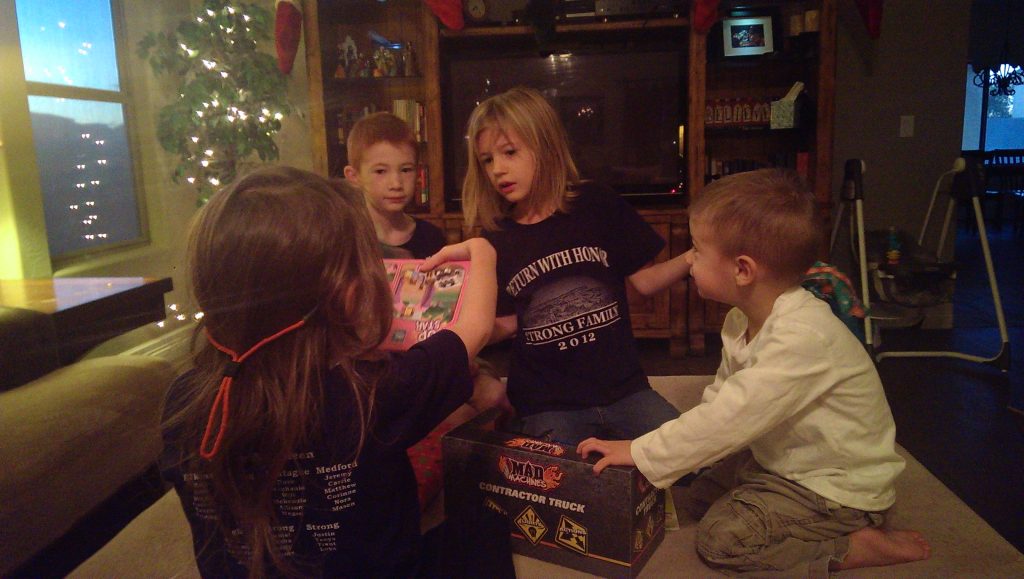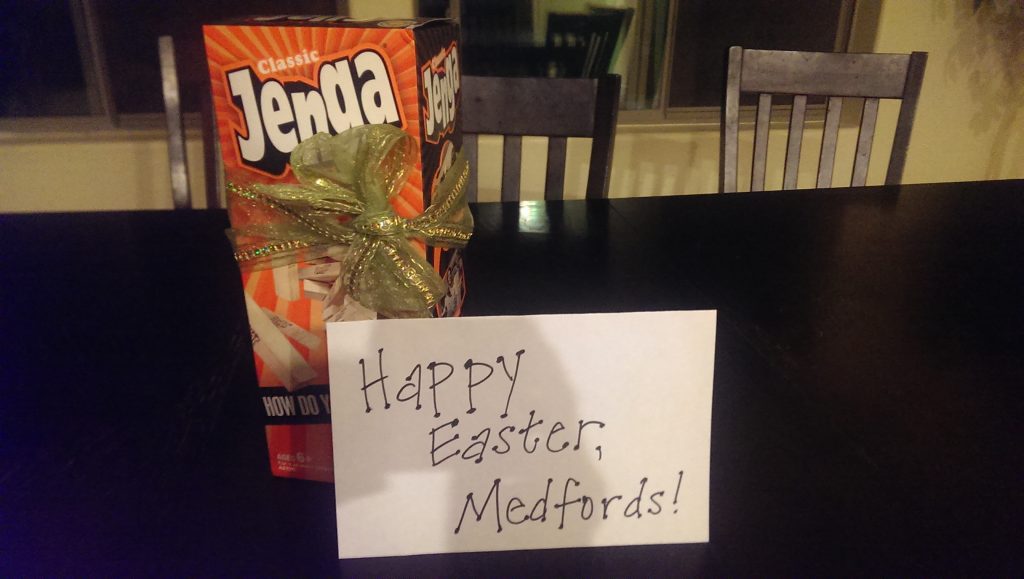To start from the beginning, go here.
Halloween was coming up and I was starting to wonder how this holiday would look with my new diet. Would I let my kids go trick-or-treating and collect hordes of candy? Would we go to the church’s Trunk-or-Treat and eat chili that was made from questionable ingredients, hot dogs loaded with chemicals, sugary treats, and more candy? I wanted to find a balance where my family could participate in the holiday without putting horrible things into their bodies. As I thought about it, the idea of “the Great Pumpkin” came to mind. I had heard of parents using this fictitious character that would come Halloween night and take the proffered candy and leave a toy in its place. This seemed like the perfect alternative to the kids devouring loads of processed sugar and yet keep Halloween exciting. The kids could still go around trick-or-treating in the neighborhood with all the other kids, and then trade in all of their candy for something more substantial. I was convinced that I could sell this idea to the kids and have them excited to give away their candy.
The church Trunk-or-Treat and chili cook-off was a little trickier. It would be harder to control what the kids were eating at a large gathering. But I found a chili recipe loosely based off of my beans and rice recipe that I could make and bring to the activity. Additionally, I would have food that I would be able to eat. I had a plan.
I brought my chili to the activity, and the kids waited in line with Jeremy to get their food. Much to my dismay, their plates were loaded with hot dogs and all kinds of processed foods that made my heart sink. I had to decide if I was going to control what they were eating at public gatherings, or just let them eat whatever and be okay with it and just keep focusing on healthy foods at home. I looked at their sweet innocent faces and I knew I couldn’t tell them that they couldn’t eat what all of the other kids were eating. I couldn’t explain to them that everyone else was eating unhealthy food and create a paradox in their mind when everyone around them looks perfectly healthy. They were too young to really understand completely. And, honestly, I wanted to be able to eat that food too. I missed the times when I could eat any food and not worry about the internal damage it was causing. So I waited until the end of the line to fill my bowl with my chili and watch with longing and judgment of those who indulged in everything else.

Once dinner was over and we went outside to the cars for the Trunk-or-Treat, I was ready. I had my bag of trinkets from Oriental Trading Co. and my ghostly porch decoration that said “Boo!” and giggled. As the kids came around I handed them their rings, and stickers, and glow-in-the-dark bracelets. They looked disapprovingly and disappointedly at the offerings, and moved on to the next car.
By the end of the night, I still had quite a few trinkets left, and the kids had more than enough candy. I explained to the kids the concept of the Great Pumpkin: that if they would leave their candy out for him, he would leave a present in return. And, the more candy they left, the bigger the present. For them, this was a no-brainer. They wanted the present! After all, candy provides just a momentary pleasure; a present could be played with over and over. So the candy ended up in a big bowl on the table, awaiting consumption by the Great Pumpkin. After the kids went to bed, Jeremy succumbed to the temptation of a few pieces of candy, and the rest went in the trash. I drove to the nearest Walmart and found a few Barbies, Lego sets, and toy cars that I knew would be well-received. The next morning when the kids woke up and checked to see if the Great Pumpkin was real, they were ecstatic to see that the candy was gone and that he really did leave them presents! The Great Pumpkin was a win!
Thanksgiving was coming up and I was feeling less constricted and more hopeful that there were options of things I could eat. My mom called and asked what she could do to make the meal something that I could participate in. We talked about the stuffing, since it’s my favorite dish on Thanksgiving, and she offered to omit the sausage and substitute homemade whole wheat bread for the store-bought white bread she typically uses. She also offered to make some whole wheat rolls with Jeremy’s bread recipe. I started thinking, “yes! This can work!” Although I knew I wouldn’t be eating the turkey or the gravy, or any of the pies, I was getting excited about the things that I could eat. I also said that I would bring a big green salad, and some Kerry Gold butter. I noticed that I was changing my mindset from thinking about all the things that I couldn’t eat, to thinking about ways that I could alter some of my favorite dishes to fit into my new diet.
A majority of my siblings and their families came for the holiday. In my family it’s a bigger holiday to congregate than Christmas. My mom still made her mouth-watering, award-winning apple pie, pumpkin pie, a mincemeat pie for my dad, and a big turkey for the feast. But there was still plenty of delicious food that I could eat. I didn’t feel like I missed out on too many of my favorite dishes. I appreciated that my mom adjusted her recipes so that I could enjoy the meal as well. But it was admittedly hard to watch everyone eat the pies and turkey that felt like such a quintessential part of the meal. I felt like I was missing out on a part of the joy that comes with the food. Maybe as a society we have made too much of an association between food and feelings. Sweets are so associated with joy that we indulge in them in an attempt to feel that same joy that we have experienced in the past, or to enjoy a temporary pleasure of senses, or to be used as a reward or bribe for achieving something. In any case, I felt like I wasn’t able to celebrate Thanksgiving to the full extent of my expectations. But it was nice to gather with my family and feel some sense of normalcy–or at least the new normal.
After the success of Thanksgiving, Christmas seemed much easier. Presents are not food-related (usually), so that felt normal. Jeremy and I usually put together a special Christmas breakfast, so this year was a bit more challenging. Jeremy and I decided to make poached eggs that we bought from a local farm and served those on toast, with homemade hollandaise sauce. It was my first attempt at poaching eggs and making hollandaise sauce, but it was delicious. We also juiced some fresh orange and apple juice with our juicer. This was a treat to have just fruit juice. I had always combined it with vegetables to reduce the amount of natural sugars absorbed into the blood. It tasted so sweet! It felt like such an indulgence. We then went to my parents house for dinner. Christmas dinner was much the same as Thanksgiving. None of my family came from out of state this time–it was just my little brother, older sister and me and our families. My mom still made the big dinner, just like she did for Thanksgiving, and once again I made a large salad to add to the meal. It had become my practice to eat a salad before indulging in any other food. That way I was sure to fill up on nutritionally dense food first. I made it through the big holidays. Life was feeling like a new normal.

The next sugar holiday was Valentine’s Day. To make it special for the kids, we made heart-shaped pizza with vegetable toppings for dinner. We had been making vegetable pizzas without cheese for awhile now. We had become used to it and didn’t feel like we were missing much without it. It was fun for the kids to celebrate Valentine’s Day in our own way. Later that evening, our church congregation had a tradition of an annual family dance with a potluck of sweets. As I struggled with what to bring, Jeremy suggested we should just bring some chips and homemade salsa. We can think outside the box and do things differently, and maybe other people will appreciate it. And if not, we can just bring home the leftovers and enjoy them ourselves. We did bring chips and salsa, and it was a popular addition to the potluck. Unfortunately, there wasn’t any left to bring home.
Easter came soon after Valentine’s Day. I never realized before just how much holidays are associated with sugar. It was frustrating and a little disgusting to me as well that society was so focused on using sweets to celebrate everything. We were creating dependence upon it for our happiness. Nevertheless, if I wanted to be social, I would have to adapt. My parents host an Easter egg hunt every year at their house on the day before Easter for their grandkids. My siblings and I usually fill some eggs with candy and hide them for the kids. This year I once again went against the status quo and filled the eggs I brought with coins. I wasn’t sure how the kids would react to getting coins, but I was against buying candy on principle. It was fun to watch the reactions of the kids as they opened their eggs to find some with candy and some with coins. They each counted how much money they found and compared with each other to see who got the most money. I was proud of myself at the time for finding a suitable substitute for candy. But looking back I think they just preferred the candy.
I struggled with what to have the Easter bunny bring. When I was a kid, the Easter bunny left us a bag full of candy. I loved that candy! It was such a memorable part of Easter–the chocolate bunnies, the nasty marshmallow Peeps, and egg shaped Reese’s. I wanted my kids to have those experiences and memories too. But I just couldn’t reconcile myself to buying candy to give to my kids when I knew how bad it was for them. I came up with the solution of buying a family game instead. That way we could use the gift for family togetherness instead of selfishly consuming individual treats. That year the Easter bunny brought the Medfords “Jenga.” The kids loved it and we had fun playing it together and seeing who would make the tower fall. Another win without sugar.

To continue the story, go here.
